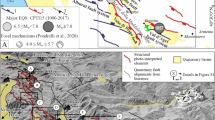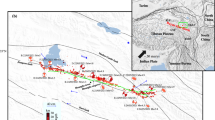Abstract
The geometry of faults is usually thought to be more complicated at the surface than at depth and to control the initiation, propagation and arrest of seismic ruptures1,2,3,4,5,6. The fault system that runs from southern California into Mexico is a simple strike-slip boundary: the west side of California and Mexico moves northwards with respect to the east. However, the Mw 7.2 2010 El Mayor–Cucapah earthquake on this fault system produced a pattern of seismic waves that indicates a far more complex source than slip on a planar strike-slip fault7. Here we use geodetic, remote-sensing and seismological data to reconstruct the fault geometry and history of slip during this earthquake. We find that the earthquake produced a straight 120-km-long fault trace that cut through the Cucapah mountain range and across the Colorado River delta. However, at depth, the fault is made up of two different segments connected by a small extensional fault. Both segments strike N130° E, but dip in opposite directions. The earthquake was initiated on the connecting extensional fault and 15 s later ruptured the two main segments with dominantly strike-slip motion. We show that complexities in the fault geometry at depth explain well the complex pattern of radiated seismic waves. We conclude that the location and detailed characteristics of the earthquake could not have been anticipated on the basis of observations of surface geology alone.
This is a preview of subscription content, access via your institution
Access options
Subscribe to this journal
Receive 12 print issues and online access
$259.00 per year
only $21.58 per issue
Buy this article
- Purchase on Springer Link
- Instant access to full article PDF
Prices may be subject to local taxes which are calculated during checkout



Similar content being viewed by others
References
Bouchon, M., Campillo, M. & Cotton, F. Stress field associated with the rupture of the 1992 Landers, California, earthquake and its implications concerning the fault strength at the onset of the earthquake. J. Geophys. Res. 103, 21091–21097 (1998).
Harris, R., Archuleta, R. & Day, S. Fault steps and the dynamic rupture process: 2-D numerical simulations of a spontaneously propagating shear fracture. Geophys. Res. Lett. 18, 893–896 (1991).
King, G. C. & Nabelek, J. The role of fault bends in faults in the initiation and termination of earthquake rupture. Science 283, 984–987 (1985).
Wesnousky, S. G. Predicting the endpoints of earthquake ruptures. Nature 444, 358–360 (2006).
Wesnousky, S. G. Displacement and geometrical characteristics of earthquake surface ruptures: Issues and implications for seismic-hazard analysis and the process of earthquake rupture. Bull. Seismol. Soc. Am. 98, 1609–1632 (2008).
Radiguet, M., Cotton, F., Manighetti, I., Campillo, M. & Douglas, J. Dependency of near-field ground motions on the structural maturity of the ruptured faults. Bull. Seismol. Soc. Am. 99, 2572–2581 (2009).
Sieh, K. et al. Near-field investigations of the Landers earthquake sequence, April to July 1992. Science 260, 171–176 (1993).
Atwater, T. & Stock, J. Pacific North America plate tectonics of the Neogene southwestern United States: An update. Int. Geol. Rev. 40, 375–402 (1998).
Fletcher, J. M. & Spelz, R. M. Patterns of Quaternary deformation and rupture propagation associated with an active low-angle normal fault, Laguna Salada, Mexico: Evidence of a rolling hinge? Geosphere 5, 385–407 (2009).
Gonzalez-Garcia, J. J. et al. Seismotectonics of the 2010 El Mayor Cucapah—Indiviso earthquake and its relation to seismic hazard in southern California. AGU (Fall Meeting) abstr. T53B-2117 (2010).
Hartzell, S. & Helmberger, D. V. Strong-motion modeling of the Imperial Valley earthquake of 1979. Bull. Seismol. Soc. Am. 72, 571–596 (1982).
Ji, C., Helmberger, D. V., Song, T-R. A., Ma, K-F. & Wald, D. J. Slip distribution and tectonic implications of the 1999 Chi–Chi, Taiwan earthquake. Geophys. Res. Lett. 28, 4379–4382 (2001).
Delouis, B., Giardini, D., Lundgren, P. & Salichon, J. Joint inversion of InSAR, GPS, teleseismic, and strong-motion data for the spatial and temporal distribution of earthquake slip: Application to the 1999 Izmit mainshock. Bull. Seismol. Soc. Am. 92, 278–299 (2002).
Ji, C., Wald, D. & Helmberger, D. V. Source description of the 1999 Hector Mine, California earthquake, part I: Wavelet domain inversion theory and resolution analysis. Bull. Seismol. Soc. Am. 92, 1192–1207 (2002).
Avouac, J. P., Ayoub, F., Leprince, S., Konca, O. & Helmberger, D. V. The 2005, Mw 7.6 Kashmir earthquake: Sub-pixel correlation of ASTER images and seismic waveforms analysis. Earth Planet. Sci. Lett. 249, 514–528 (2006).
Lohman, R. B. & Simons, M. Some thoughts on the use of InSAR data to constrain models of surface deformation: Noise structure and data downsampling. Geochem. Geophys. Geosyst. 6, Q01007 (2005).
Hauksson, E. et al. The 2010 Mw 7.2 El Mayor–Cucapah earthquake sequence, Baja California, Mexico and southernmost California, USA: Active seismotectonics along the Mexican Pacific margin. Pure Appl. Geophys. Top. Issue: Geodyn. Mexican Pacific Margin, 10.1007/s00024-010-0209-7 (2010).
Blanpied, M. L., Lockner, D. A. & Byerlee, J. D. Frictional slip of granite at hydrothermal conditions. J. Geophys. Res. 100, 13045–13064 (1995).
Yagi, Y., Kikuchi, M. & Sagiya, T. Co-seismic slip, post-seismic slip and aftershocks associated with two large earthquakes in 1996 in Hyugia-nada, Japan. Earth Planet. Space 53, 793–803 (2001).
Hsu, Y. J. et al. Frictional afterslip following the 2005 Nias-Simeulue earthquake, Sumatra. Science 312, 1921–1926 (2006).
Sladen, A. et al. Source model of the 2007 Mw 8.0 Pisco, Peru earthquake: Implications for seismogenic behavior of subduction megathrusts. J. Geophys. Res. 115, B02405 (2010).
Tilmann, F. J. et al. The updip seismic/aseismic transition of the Sumatra megathrust illuminated by aftershocks of the 2004 Aceh-Andaman and 2005 Nias events. Geophys. J. Int. 181, 1261–1274 (2010).
Ellsworth, W. L. & Beroza, G. C. Seismic evidence for an earthquake nucleation phase. Science 268, 851–855 (1995).
Michel, R., Avouac, J. P. & Taboury, J. Measuring near field coseismic displacements from SAR images: Application to the Landers earthquake. Geophys. Res. Lett. 26, 3017–3020 (1999).
Van Puymbroeck, N., Michel, R., Binet, R., Avouac, J. P. & Taboury, J. Measuring earthquakes from optical satellite images. Appl. Opt. 39, 3486–3494 (2000).
Leprince, S., Barbot, S., Ayoub, F. & Avouac, J. P. Automatic and precise orthorectification, coregistration, and subpixel correlation of satellite images, application to ground deformation measurements. IEEE Trans. Geosci. Remote Sensing 45, 1529–1558 (2007).
Acknowledgements
This work was financially supported by NSF, USGS, the Gordon and Betty Moore Foundation, NASA and SCEC. Regional seismic data were provided by SCSN and RESNOM. The Incorporated Research Institutions for Seismology (IRIS) Data Management System (DMS) was used to access the Global Seismographic Network data. The GPS analyses were obtained from the Earthscope PBO data products system and UNAVCO. Optical data were provided by USGS. Envisat data are copyright 2009, 2010 ESA and were obtained from the WInSAR archive and the Group on Earth Observation Geohazards Supersite virtual archive. ALOS data are copyright METI, JAXA and were obtained from the Alaska Satellite Facility Level 1 Data Pool. Part of this research was carried out at the Jet Propulsion Laboratory, California Institute of Technology under contract with the National Aeronautics and Space Administration. We thank CICESE colleagues J. Gonzalez and J. Fletcher for their support and interest, and we thank J. Hollingsworth for his suggestions to improve the figures. This is Tectonics Observatory contribution #172. SCEC is funded by NSF Cooperative Agreement EAR-0529922 and USGS Cooperative Agreement 07HQAG0008.
Author information
Authors and Affiliations
Contributions
S.W. carried out the modelling and edited the paper; E.F. carried out the InSAR and SAR processing and edited the paper; S.L. carried out the optical image and SAR cross-correlation processing; A.S. helped with the modelling and downsampled the InSAR and SAR data; J-P.A. conceived and supervised the research and editing of the paper; D.H. supervised the research and edited the paper; E.H. carried out relocation of aftershocks and foreshocks; R.C. carried out modelling of teleseismic data; M.S. provided InSAR data; K.H. edited the paper and provided geological interpretation; T.H. carried out the processing of GPS data; R.B. contributed to the tectonic interpretation.
Corresponding author
Ethics declarations
Competing interests
The authors declare no competing financial interests.
Supplementary information
Supplementary Information
Supplementary Information (PDF 2905 kb)
Rights and permissions
About this article
Cite this article
Wei, S., Fielding, E., Leprince, S. et al. Superficial simplicity of the 2010 El Mayor–Cucapah earthquake of Baja California in Mexico. Nature Geosci 4, 615–618 (2011). https://doi.org/10.1038/ngeo1213
Received:
Accepted:
Published:
Issue Date:
DOI: https://doi.org/10.1038/ngeo1213
This article is cited by
-
Irregular rupture process of the 2022 Taitung, Taiwan, earthquake sequence
Scientific Reports (2023)
-
Quantifying the probability and uncertainty of multiple-structure rupture for Taiwan
Terrestrial, Atmospheric and Oceanic Sciences (2023)
-
Irregular rupture propagation and geometric fault complexities during the 2010 Mw 7.2 El Mayor-Cucapah earthquake
Scientific Reports (2022)
-
Characteristics of secondary-ruptured faults in the Aso Caldera triggered by the 2016 Mw 7.0 Kumamoto earthquake
Earth, Planets and Space (2020)
-
Mechanics of near-field deformation during co- and post-seismic shallow fault slip
Scientific Reports (2020)



